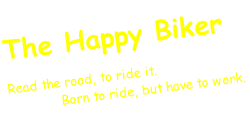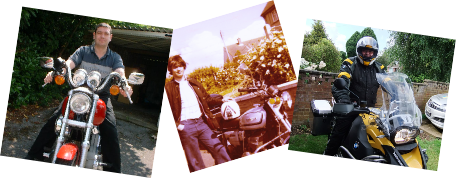


Andrew Anderson © 2015 The Happy Biker All Rights Reserved
OK! For the new guys and for those who need a little reminder.
People who consider the 'OAP' doctrine of RoadCraft and ally that with concentration and courtesy, or adopt 'COAST
OAP - Observation, Anticipation, Planning
What does COAST mean please?
By using Concentration, Observation and Anticipation, you give yourself Space and
Time. (to react)
C
CONCENTRATION (and it also means COURTESY AND CONSIDERATION)
I reckon concentration should be a relaxed concentration. By this I mean that if you consciously try to concentrate - you may be concentrating on what you perceive to be correct behaviour and not concentrating at all. It is the sort of concentration which you use when watching a good film - looking at the points of interest and the nuances of the plot. It is a bout leaving the worries of what to have for tea or the argument with the boss or the wife or the best pal behind and focusing on the drive and the road ahead - watching the road furniture "tell you a story of what to expect ahead".
It is about not getting carried away by your CD player playing "Born to be Wild" - loudly!
It is about refraining from eating apples whilst driving, reading maps, and arguing with passengers or on the hands free set whilst driving.
Consideration is about being understanding: the person may have just passed the test or be new to the area.
It is about accepting people do make errors and not getting worked up about it. It
is about dealing with it - safely.
O
OBSERVATION
This means what it says - use sight, ears and smell.
You need to scan systematically. The road paint on the road tells you about the hazards to expect (Check out "Know Your Road Signs!" (DSA publication).
It means using mirrors. and constantly adjusting your driving (and riding if on two wheels and I do include the cyclist contingent and lurkers on here in this too )
It means looking at the road layout - continuously assessing the moving point and the limit point on the road as it unfolds ahead of you.
It means observing other traffic: the ball under the parked car, the potential chap who may open the door or just set off without the life saver glance over his shoulder (and again this applies to cyclists as they are the ones who get caught the most by this numpty error )
It means positioning for view (see Ian's excellent diagram on cornering and apex in the "Cornering" thread in the "Improve Driving" forum on this site) Positioning for view depends on circumstances at the time -but you need to ensure you can observe the antics of the driver at least two cars ahead of you!
It means keeping eyes moving and using peripheral vision.
It means being aware of that line of persons at a bus stop means bus is around here somewhere.
It means using every means of observation at your disposal.
Smell of cut grass? Council workers on the loose.
A
ANTICIPATION
More time you have to react to a hazard - the better.
It is based on your observations. Their behaviour, position, head , hand and general progress all give you clues. Never assume they will behave as you do.
Once you have observed and anticipated - you then have to plan - take control of the situation. react to the hazards ahead and defend yourself. Because "PLAN" is so difficult to define we split this as follows:
S
SPACE
This is the two second rule. You give space to the tailgater and increase your space for reactions.
It means adjusting speed to the safest one for the conditions ahead. It means reacting to what might reasonably be expected to happen and you are responding to what can be seen and what cannot be seen
It is about dropping your speed so that you can see what is happening 2- 3 vehicles ahead of you.
T
TIME
Time is linked to the above. Only a fool breaks the two second rule! It is your two second gap. It is the time you allowed for your journey. It is the time you allow for other road users in your planning and decisions based on the above OAP per "ROADCRAFT"
There are lots of variations of COAST - but these are the main ones.
Also: For when you not concentrating.
Camera
On
Any
Speculative
Target